The story so far: China achieved a new milestone on May 30 when it sent its first civilian into space— payload specialist Professor Gui Haichao, who works with Beijing’s Beihang University.
Apart from Mr. Gui, mission commander Jing Haipeng and spacecraft engineer Zhu Yangzhu reached China’s Tiangong space station at 4:29 PM, aboard the Shenzhou 16 spacecraft. The three-member crew will complete a five-month mission at the space station, relieving the Shenzhen 15 crew, which has been at the space station for six months and is set to return to Earth in June.
With the successful landing of a second manned crew aboard its space station, the Chinese Manned Space Agency aims to land astronauts on the moon before 2030.
On the other hand, the US plans to send a manned crew to the moon by 2025 under the Artemis programme. Under the Artemis-I mission, it launched the Orion spacecraft, which returned to NASA’s Kennedy Space Center in Florida on December 11 after completing its 1.4-million-mile journey from Earth to the moon and back.
Here’s a look at the two competitive moon missions.
What is the Artemis programme?
Succeeding the Apollo missions which sent seven manned crews to the moon and back between 1969 and 1972, the Artemis programme aims to land on the moon, set up a long-term base and then send the first astronauts to Mars.
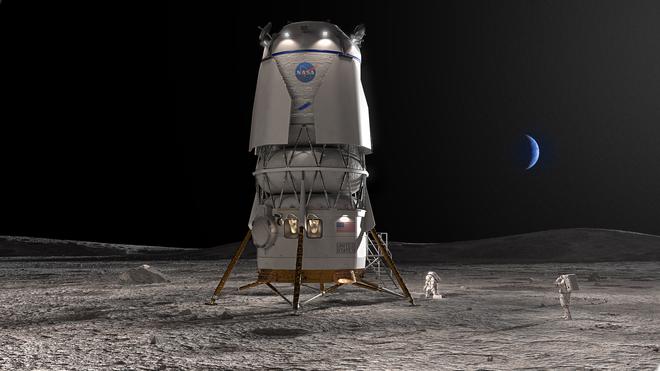
Led by the US, the programme is a joint venture of several countries, including Australia, Canada, Italy, Japan, Luxembourg, the United Arab Emirates, the United Kingdom, Ukraine, South Korea, New Zealand, Brazil, Poland, Mexico, Israel, Romania, Bahrain, Singapore, Colombia, France, Saudi Arabia, Rwanda, Nigeria, Czech Republic, and the latest to join, Spain. These countries are signatories of an open treaty called the ‘Artemis accords’ which aims to put humans back on the moon.
The programme’s initial three missions are titled Artemis-I, II and III.
Artemis-I
For Artemis I, NASA built a super heavy-lift launch vehicle called the ‘Space Launch System’ (SLS) — its most powerful till date — to carry its spacecraft , astronauts, and cargo directly to the moon on a single mission. NASA also built a human spacecraft named ‘Orion’ for deep-space missions to travel to the moon and Mars. It can also carry a human crew to space, provide emergency abort capability, sustain astronauts during their missions and provide safe re-entry from deep space.
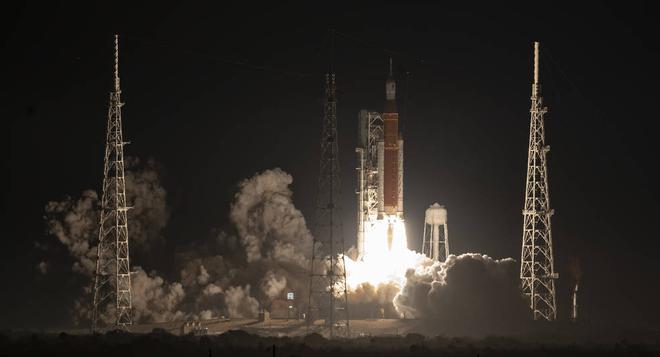
On November 16, 2022, the SLS carrying Orion lifted off from NASA’s Kennedy Space Center to commence its first uncrewed integrated flight test. After a systems check, the main engine and the interim cryogenic propulsion stage (ICPS) separated from Orion, committing it to a lunar trajectory. After completing a lunar flyby, Orion performed a half revolution around the moon (43,730 miles from the lunar surface), before returning to earth’s orbit and splashing down on December 11, 2022 in the Pacific Ocean, within view of the U.S. Navy recovery ship.
Artemis-II
Under Artemis-II, NASA plans to launch a crew of four astronauts onboard the SLS, perform multiple manoeuvres on an expanding orbit around the Earth on the Orion, do a lunar flyby and return back to Earth. The ten-day mission is slated for 2024.
As per its scheduled timeline, the SLS will initially launch the Orion along with the four-member crew similar to Artemis-I. Prior to the separation of the ICPS, the Orion will orbit the Earth twice to check if all systems of the spacecraft are functional while still close to Earth. After the second orbit, the Orion will separate from the ICPS to continue its journey to the moon.
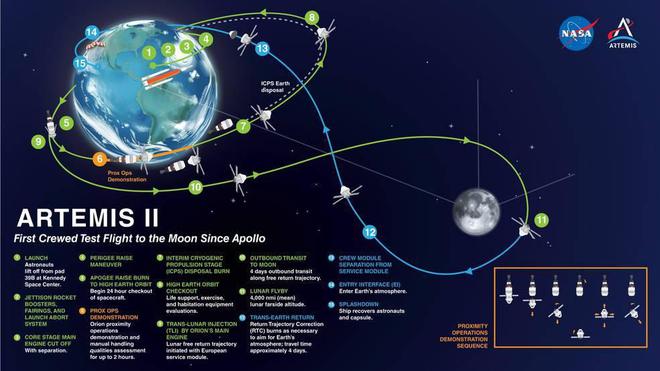
Before it enters lunar orbit, the crew will use the ICPS as a target for a proximity operations demonstration. Using onboard cameras and the spacecraft’s windows, the crew will manually approach the ICPS and then back away from it. This demonstration will ultimately help in critical rendezvous, proximity operations and docking and undocking for Artemis-III.
The crew will also perform tests on other systems like communication, life support, and navigation before Orion’s service module pushes the spacecraft to its path to the moon. Orion will travel along the back side of the moon for four days, before doing a lunar flyby and returning to the earth. Aboard the Orion, the crew’s module will separate from the service module, enter the earth’s atmosphere and splash down.
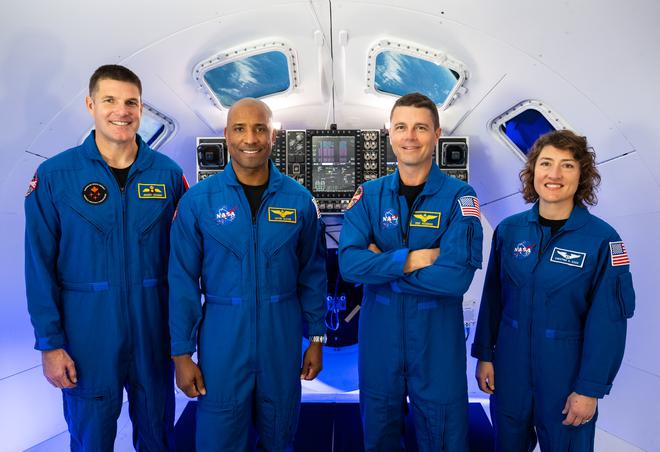
NASA has finalised its four-member crew for Artemis— Reid Wiseman (commander) from Canada, and Victor Glover (pilot), Christina Hammock Koch (mission specialist) and Jeremy Hansen (mission specialist) from the US. Mr. Glover will create history as the first non-white person to land on the moon while Ms. Koch will be the first woman to do so. The crew is now undergoing training while different modules of Orion are undergoing tests.
Artemis-III
Artemis-III will mark the return of humans to the moon in 2025. Similar to Artemis-I and II, the crew onboard the Orion will be launched to the moon. After the ICPS pushes the Orion towards the lunar orbit, the Orion will perform two engine burns to set itself on a Near-Rectilinear Halo Orbit (NRHO) in the moon’s gravitational orbit. The NHRO will help to establish a landing site on the moon.
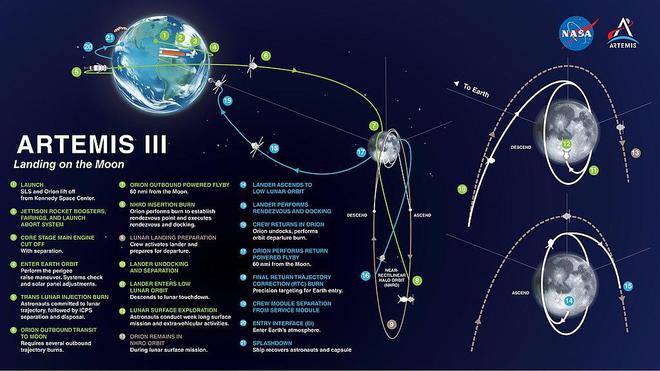
After preparation, the lunar lander will separate from the spacecraft — which will continue to be in the NHRO, enter the lower lunar orbit and land on the moon. The crew will conduct a week-long lunar exploration and return to the lander which will first ascend to the low lunar orbit before docking on the Orion. The spacecraft will then perform a lunar flyby before returning to Earth.
NASA has selected SpaceX to provide the lunar lander which will transport the crew from Orion to the surface of the moon and back again.
Artemis IV and onwards
In Artemis IV, NASA aims to land a second crew on the moon in 2028 and establish a Lunar Gateway station whose components will be launched prior to the Artemis IV mission to the NHRO. Successive missions will see a crew landing at the Lunar Gateway station in 2029 along with several components required for moon exploration by different countries. The aim is to set up a permanent base on the lunar surface and then proceed to send astronauts to Mars from the moon.
China’s Moon mission
Chang’ e 1 to 5
Dubbed as the Chang’e mission, the Chinese Lunar Exploration Program has already launched two lunar orbiters (Chang’ e 1 & 2) and two lunar rovers (Chang’e 3 & 4) — one on the unexplored south pole of the far side of the moon.
The Chinese launched Chang’e 5 on November 23, 2020, onboard its Long March 5 rocket. . The spacecraft entered the lunar orbit on November 28, 2020, and its descender slowly soft-landed in the Mons Rumker region of Oceanus Procellarum on the south pole of the moon. The lander scooped, drilled and collected samples of the lunar surface and transferred them to the ascender via a robotic arm.
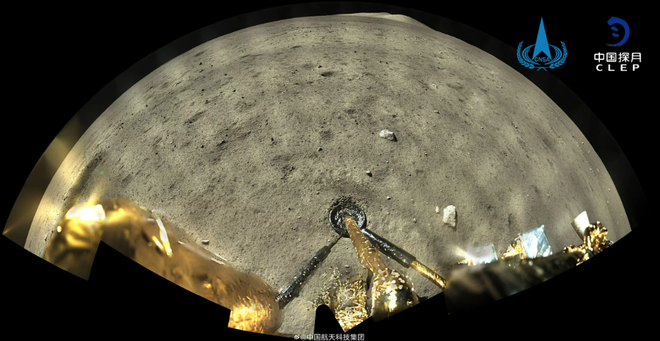
The ascender lifted off to lunar orbit and transferred them to the return capsule via the lunar orbiter on December 3, 2020. The return capsule with the orbiter entered the earth’s orbit after five days. While the orbiter separated from the return capsule and headed to the Sun-Earth Lagrange point L1 for its next mission, the capsule landed in the Siziwang Banner grassland of Inner Mongolia in north China on December 17. The recovered sample of lunar regolith (the loose unconsolidated rock and dust atop bedrock) was found to weigh 1.731 kg.
Chang’ e 6,7 & 8
Currently, China aims to continue its research of the moon’s south pole, sending two missions — Chang’e 6 and Chang’e 7 — in 2024 and 2026 to bring back samples. Chang’ e 7 comprises an orbiter, a relay satellite, a lander, and a mini-flying probe and will explore the lunar south pole for resources. It will also aim to detect water ice in the permanently shadowed area.

China further plans to build a permanent science base on the moon. Towards this end, Chang’ e 8 will carry a lander, a rover, and a flying detector along with a 3D-printing module to test the construction of a lunar base.
International Lunar Research Station
Constructing a lunar base is a joint venture between China and Russia. On April 29, 2021, the two nation’s space agencies _ China National Space Administration and Russia’s State Space Corporation (Roscosmos) — issued a joint statement that they will collaborate in the construction of an International Lunar Research Station (ILRS) for the peaceful exploration and use of the Moon.
The station will be equipped with energy supplies, communications and navigation, space shuffling, lunar research and ground support services and a command centre. Apart from Russia, Pakistan, Argentina and international organizations including the Asia Pacific Space Cooperation Organization have agreed to participate in the project, while at least ten other countries are considering it.
With the formation of two rival camps — the Artemis Accords headed by the US and the International Lunar Research Station (ILRS) headed by China, the war to step on the moon has heated up.







